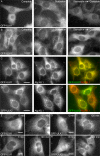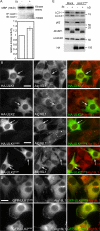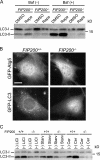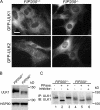FIP200, a ULK-interacting protein, is required for autophagosome formation in mammalian cells
- PMID: 18443221
- PMCID: PMC2364687
- DOI: 10.1083/jcb.200712064
FIP200, a ULK-interacting protein, is required for autophagosome formation in mammalian cells
Abstract
Autophagy is a membrane-mediated intracellular degradation system. The serine/threonine kinase Atg1 plays an essential role in autophagosome formation. However, the role of the mammalian Atg1 homologues UNC-51-like kinase (ULK) 1 and 2 are not yet well understood. We found that murine ULK1 and 2 localized to autophagic isolation membrane under starvation conditions. Kinase-dead alleles of ULK1 and 2 exerted a dominant-negative effect on autophagosome formation, suggesting that ULK kinase activity is important for autophagy. We next screened for ULK binding proteins and identified the focal adhesion kinase family interacting protein of 200 kD (FIP200), which regulates diverse cellular functions such as cell size, proliferation, and migration. We found that FIP200 was redistributed from the cytoplasm to the isolation membrane under starvation conditions. In FIP200-deficient cells, autophagy induction by various treatments was abolished, and both stability and phosphorylation of ULK1 were impaired. These results suggest that FIP200 is a novel mammalian autophagy factor that functions together with ULKs.
Figures








Similar articles
-
Role of ULK-FIP200 complex in mammalian autophagy: FIP200, a counterpart of yeast Atg17?Autophagy. 2009 Jan;5(1):85-7. doi: 10.4161/auto.5.1.7180. Epub 2009 Jan 13. Autophagy. 2009. PMID: 18981720
-
ULK-Atg13-FIP200 complexes mediate mTOR signaling to the autophagy machinery.Mol Biol Cell. 2009 Apr;20(7):1992-2003. doi: 10.1091/mbc.e08-12-1249. Epub 2009 Feb 18. Mol Biol Cell. 2009. PMID: 19225151 Free PMC article.
-
ULK1.ATG13.FIP200 complex mediates mTOR signaling and is essential for autophagy.J Biol Chem. 2009 May 1;284(18):12297-305. doi: 10.1074/jbc.M900573200. Epub 2009 Mar 3. J Biol Chem. 2009. PMID: 19258318 Free PMC article.
-
The mammalian ULK1 complex and autophagy initiation.Essays Biochem. 2017 Dec 12;61(6):585-596. doi: 10.1042/EBC20170021. Print 2017 Dec 12. Essays Biochem. 2017. PMID: 29233870 Free PMC article. Review.
-
The role of the Atg1/ULK1 complex in autophagy regulation.Curr Opin Cell Biol. 2010 Apr;22(2):132-9. doi: 10.1016/j.ceb.2009.12.004. Epub 2010 Jan 6. Curr Opin Cell Biol. 2010. PMID: 20056399 Review.
Cited by
-
An overview of autophagy: morphology, mechanism, and regulation.Antioxid Redox Signal. 2014 Jan 20;20(3):460-73. doi: 10.1089/ars.2013.5371. Epub 2013 Aug 2. Antioxid Redox Signal. 2014. PMID: 23725295 Free PMC article. Review.
-
FIP200 is required for maintenance and differentiation of postnatal neural stem cells.Nat Neurosci. 2013 May;16(5):532-42. doi: 10.1038/nn.3365. Epub 2013 Mar 31. Nat Neurosci. 2013. PMID: 23542691 Free PMC article.
-
Regulation and functional significance of autophagy in respiratory cell biology and disease.Am J Respir Cell Mol Biol. 2013 Jan;48(1):1-9. doi: 10.1165/rcmb.2012-0282TR. Epub 2012 Sep 13. Am J Respir Cell Mol Biol. 2013. PMID: 22984088 Free PMC article. Review.
-
Unraveling Cell Death Pathways during Malaria Infection: What Do We Know So Far?Cells. 2021 Feb 23;10(2):479. doi: 10.3390/cells10020479. Cells. 2021. PMID: 33672278 Free PMC article. Review.
-
Dissecting the function of Atg1 complex in Dictyostelium autophagy reveals a connection with the pentose phosphate pathway enzyme transketolase.Open Biol. 2015 Aug;5(8):150088. doi: 10.1098/rsob.150088. Open Biol. 2015. PMID: 26246495 Free PMC article.
References
-
- Bamba, N., T. Chano, T. Taga, S. Ohta, Y. Takeuchi, and H. Okabe. 2004. Expression and regulation of RB1CC1 in developing murine and human tissues. Int. J. Mol. Med. 14:583–587. - PubMed
-
- Carragher, N.O., and M.C. Frame. 2004. Focal adhesion and actin dynamics: a place where kinases and proteases meet to promote invasion. Trends Cell Biol. 14:241–249. - PubMed
Publication types
MeSH terms
Substances
LinkOut - more resources
Full Text Sources
Other Literature Sources
Molecular Biology Databases
Research Materials
Miscellaneous

